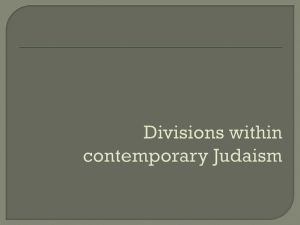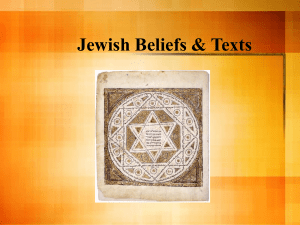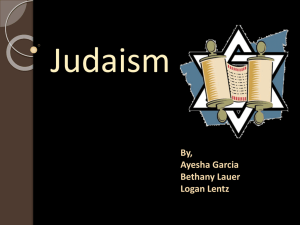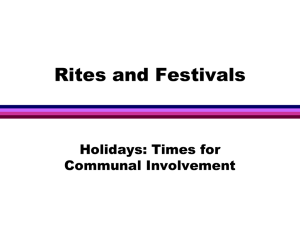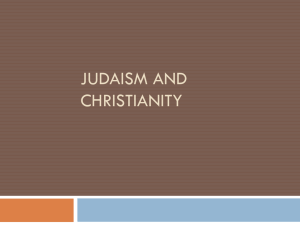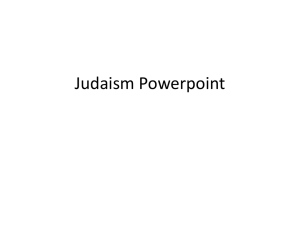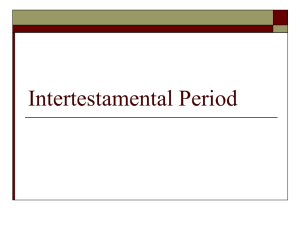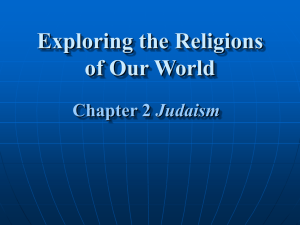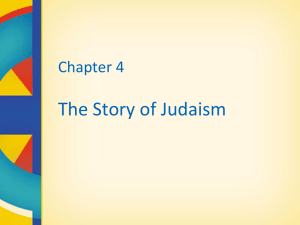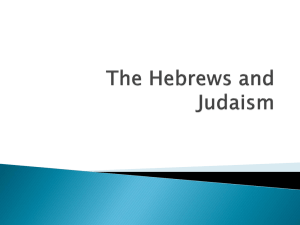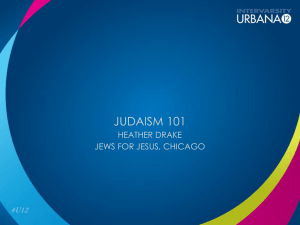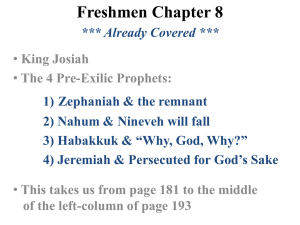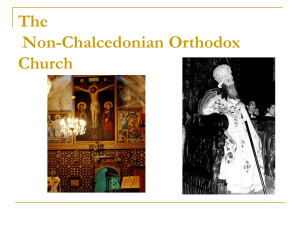File - BCE Teaching Judaism
advertisement
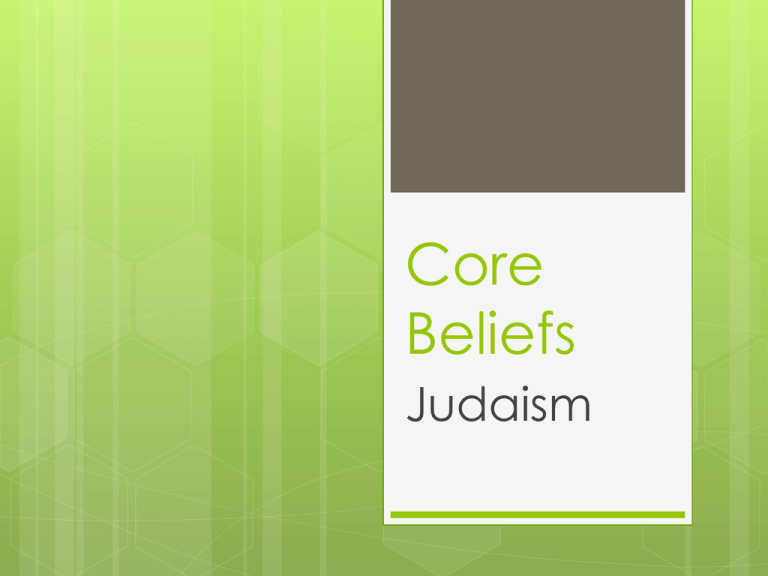
Core Beliefs Judaism Judaism is one of the world’s oldest religions, dating back approximately four thousand years. The belief in one God, who is personal and intervenes in human history, set Judaism apart from other religions of the ancient world. This concept is illustrated in the book of Exodus which tells the story of Moses leading the Hebrew people from slavery in Egypt to freedom in the promised land. Jews are often referred to as a ‘covenant people’. The covenant was made between G_d and the Jews when they escaped from Egypt and received the Ten Commandments through Moses on Mount Sinai. Jews believe that this covenant with G_d continues through time and history. The integral concept of covenant is also reflected in Jewish ceremonies such as the Brit Milah, where a baby boy is circumcised as a physical mark of the covenant that was made. Relationship with G-d Jews believe that there is a single G_d who not only created the universe, but with whom every Jew can have an individual and personal relationship. They believe that G_d continues to work in the world, affecting everything that people do. The Jewish relationship with God is a covenant relationship, therefore Jews try to keep G_d's laws, as outlined in the Torah, and bring holiness to every aspect of their lives. There are 613 mitzvot, or commandments, found in the Torah and Talmud which Jews can follow in order to bring holiness to their lives. These laws include food and dietary laws which can take the form of keeping ‘kashrut’ or ‘kosher’ in Jewish households. Kosher refers to food that is fit for consumption according to Jewish religious law, and the rules can be summed up in seven fundamental principles that include the type of animal and the manner in which the animal is killed. Also practiced is the separation of dairy and meat products. Because of the need for constant vigilance in this regard, many Jews have adopted vegetarianism. In homes that keep kosher though, there are separate areas in the kitchen for the preparation of meat and dairy. There are also different plates and cutlery as meat and dairy products and not meant to touch in any way. Groups within Judaism There are three main groups within Judaism; Reform Judaism, Orthodox Judaism, and Conservative Judaism. Orthodox Judaism is the most traditionally observant of the three streams of Judaism. Reform, or progressive, Judaism adapts its beliefs and practices to the ways of modern society. Conservative Judaism holds a middle position within Jewish society. Orthodox Judaism Orthodox Jews practice full observance of Jewish religious laws (halakhah). They believe that the law recorded in the Torah is a direct expression of G-d’s will and it is therefore unchanging. Orthodox Jews accept changes in the halakhah but they must be based on specific religious texts, codes and commentaries. The changes must also be recognised by the rabbinical authority. Orthodox Judaism has had three major stages of development from the late 1700’s through to the end of World War II. The stages led to emergence of two main groups within Orthodox Judaism – Modern Orthodox (Zionist) and Haredi (anti-Zionist). The Haredim and Hasidic Jews are the most obvious of the two Orthodox groups as they preserve the traditional dress of their European ancestors – long black coats, hats and beards for males, and modest dresses for women. Reform Judaism Reform Judaism is also known as Progressive or Liberal Judaism. This group within Judaism emerged in the late 1700’s with the emancipation of the Jews. Reform Jews therefore believe in change and accept that ideas of the divine are expressed in human terms. Thus belief and practice may change and evolve. Reform Judaism is influenced by social, scientific, and ethical developments in modern society. This belief in change is also mirrored in the design of the Reform synagogues which, unlike Orthodox synagogues, do not separate men and women. Conservative Judaism Conservative Jews are more traditional than Reform Jews but less traditional than the Orthodox Jews. The belief in the ongoing authority of Jewish law is shared with Orthodox Jews, yet Conservative Jews stress the historical development of Judaism. They therefore believe that Jewish law can be changed. Conservative Judaism is the largest group within Judaism, particularly in America. It is very rare for Conservative Jews to inter-marry, and maintaining traditional Jewish practices is important. The key difference between Conservative and Orthodox Jews is the role of women. Unlike Orthodox Judaism, Conservative Judaism allows women to read from the Torah in synagogues, to lead services, and in some cases be counted in the minyan. Conservative Judaism therefore attracts many Jews because it maintains tradition “without being rigorous, and stresses communal standards without compromising personal autonomy” (Golburg, 2009, p.214) Further Information http://www.jewfaq.org/g-d.htm http://www.bbc.co.uk/religion/religions/judaism/b eliefs/beliefs_1.shtml http://www.youtube.com/watch?v=DL7M7Y1A2Jk &feature=related Reference Goldburg, Peta. Investigating World Religions. Cambridge University Press, New York, 2009. Gwynne, Paul. World Religions in Practice: A Comparative Introduction. Blackwell Publishing, MA, 2009.
